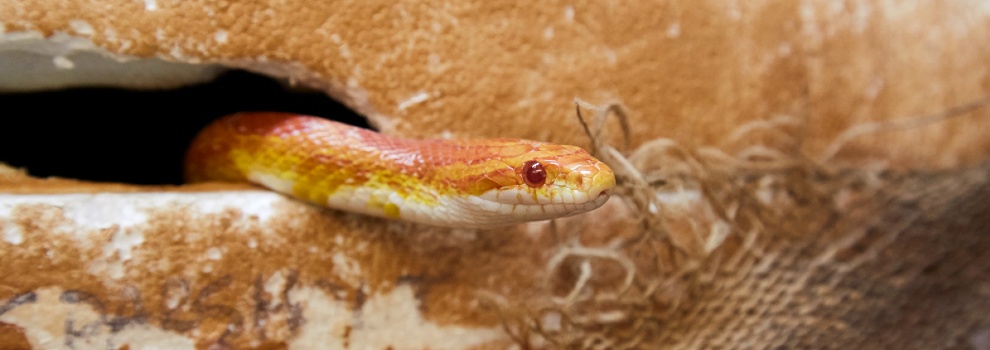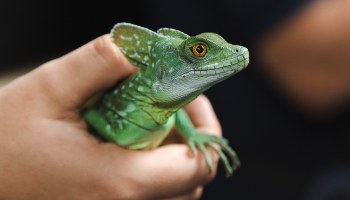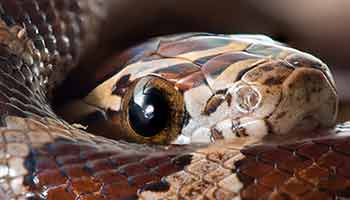Biology
Corn snakes live in a large range of habitats in the wild but they’re named for their tendency to be found in and near corn barns, feeding on rodents – though they also take birds, other reptiles and amphibians. They’re mainly terrestrial (live on the ground) and often hide in rodent burrows and under logs, but can also climb well. They are mainly active at dawn and dusk and are quite placid.
They aren’t venomous, instead using constriction to kill their wild prey. Corn snakes can grow to around 150cm long, with males normally smaller.
Corn snakes in the UK will be captive bred rather than than wild caught. There are now many colour and pattern variants called ‘morphs’ available.
Environment
Your snake’s enclosure, called a vivarium, must be secure to prevent escape and free from hazards that might cause injury. Good ventilation is essential to prevent the build-up of harmful bacteria and it should be made from a solid material that is easy to clean and holds heat.
A corn snake needs a vivarium which allows them to fully stretch out. Not only do corn snakes show a strong preference for larger enclosures, they are also more active.
Allow at least a third of the snake’s length for the width and height. For example, a 150cm long corn snake will need a vivarium that measures a minimum of 150cm long, 50cm wide and 50cm deep. A hatchling corn snake may become stressed in a large vivarium, which is linked to predator avoidance. Therefore, you should house the snake in a small vivarium and moved up sizes as they grow, or provided with plenty of small confined spaces within a larger vivarium.
Temperature
Reptiles are ectothermic, meaning they use their environment to warm up and cool down, so you need to create a thermogradient. This means positioning a heat source at one end of the vivarium – creating a basking zone – while leaving the opposite end cool, so that the snake can move around to regulate their temperature.
To create a basking zone, position a heat lamp at one end of the enclosure pointing downwards. Heat lamps must be guarded to prevent burns or injuries should the bulb shatter. A thermostat, a simple device that regulates the temperature, must be used with all heat sources. For the heat lamp, place the thermostat probe just above the substrate at the level where the snake will sit. Adjust the thermostat while checking the basking temperature using a digital thermometer until the basking zone reaches 28–30°C.
A reptile heat mat under one side of the vivarium is recommended for a smaller enclosure, such as one used for hatchlings. In this case, use an on/off thermostat with the probe in the hot end, set at 30°C.
The cool end should be 20–24°C. Thermostats aren’t accurate so it’s essential to record the temperatures daily – use one digital thermometer at the cool end and another at the basking zone. An infrared thermometer can also be used to check the temperature in the basking zone and cool end daily.
With normal household temperatures, turn off the heat source at night to simulate night-time, when it can safely drop to 16–20°C. If the room temperature drops lower than this, you’ll need non-light emitting heat at night, such as a ceramic heater or safely set-up heat mat. The vivarium should be placed in a safe location away from draughts and sources of heat, such as radiators and direct sunlight, as these affect the temperature.
Humidity
The correct humidity is essential for your snake, for a healthy respiratory system and skin shedding cycle. A hygrometer measures the humidity inside the vivarium, which should be around 40–50 percent. If it’s too high, your vivarium will need more ventilation.
Light
Reptiles use natural daylight to set their day and night patterns. Sunlight contains visible light and ultraviolet (UV). Part of UV is called UVB, which allows reptiles to make vitamin D3, vital to be able to store and use calcium. Another part is called UVA, essential for their vision, as they can see many more colours when exposed to UVA.
Create a photogradient, from light to shade, by grouping your light with the heat source. The cool end should be more shaded, just as in the wild. Fit a low-output, two to seven percent reptile UVB tube, between one-half and one-third of the vivarium length, into the roof of the vivarium as far into the hot end as possible. Use a reflector of the correct length to direct the light onto your corn snake.
UVB decreases with distance, so in a taller vivarium you may need to use a higher percentage UVB tube. Follow the UVB tube manufacturer’s recommendations regarding distance between the lamp and the snake. The UVB output decreases over time so check the UVB output regularly using an appropriate UV Index (UVI) meter positioned at the level of the animal directed towards the UV lamp.
Corn snakes require a gradient of UVB within their enclosure ranging from UVI 1.0 in the basking zone to zero in the shade. Some morphs of corn snakes, like albinos, will need lower UVB levels, with a gradient from 0 in the shade to a maximum of 0.7 in their basking zone.
The lamp must also be replaced according to the manufacturer’s instructions, and always be guarded to prevent burns, or injuries should the bulb shatter.
Make sure you turn off all lights at night. Both your lights and heat lamp can be controlled using a simple plug-in timer – 12 hours on during the day and 12 hours off at night.
Cleaning
Poorly maintained enclosures can become dirty quickly. Animal waste should be spot cleaned as soon as it appears. Once a month, use a reptile-safe disinfectant (available from pet shops) to fully clean the vivarium walls, glass and decorations, then rinse off well.
Wash your hands before and after handling your snake or their equipment, to reduce the spread of infection between you and the snake, as reptiles can carry salmonella.
Diet
Water
Provide a dish filled with clean, fresh water at the cool end of the vivarium, and replace it at least daily. It should be large enough to allow the snake to bathe. Sometimes the snake will foul the water, in which case change it as quickly as possible.
Feeding
In the wild, corn snakes consume a wide variety of prey but most are not easily available. Feed a diet of dead mice, available from pet shops. Hatchling corn snakes start on one baby mouse, called a ‘pinky’, every five to six days and move up sizes as they grow, up to one adult mouse every seven to 14 days. As a rule, offer prey that is slightly wider than the widest part of the snake’s body.
Feeding other prey – such as quails and rats – once a month or so increases variation in their diet. Regular weighing is important to ensure that your snake doesn’t become underweight or obese. Feed your snake inside their vivarium, using tongs to offer the prey.
Corn snakes shouldn't need supplements for their diets, as long as they're fed good quality prey.
Behaviour
Enrichment
It’s important to provide opportunities for natural behaviour, and choice and control over their environment, in captivity. This is called enrichment. Corn snakes show a strong preference for enriched housing over less complex environments.
Corn snakes are active and will climb if given the opportunity, so provide branches or peg boards for this (sterilise natural branches with boiling water first).
Snakes will typically hide in small spaces such as animal burrows in the wild. Include at least two hides, one at either end of the vivarium, so that the snake can choose the temperature without having to compromise feeling secure. Provide a choice of hiding places at and above ground level, for example securely hanging from branches.
Hides must be large enough for the snake to fit inside, but not so large that their body doesn’t touch the sides when coiled up. A third hide containing moistened moss, called a ‘humid hide’, can provide variation in humidity within the vivarium.
Substrate
Substrate is the name for the floor covering in your vivarium. It’s important as it provides something for the snake to burrow under, which helps them to feel more secure. It also stops mess from spreading, though you must still clean it as soon as it appears.
Substrates such as organic soils or soil/sand mixes made for reptiles are recommended for corn snakes. Don’t use sand alone as it could irritate the snake’s skin.
You can add dry, natural leaves to provide cover and a more naturalistic environment. A clean mix of 60 percent soil, 30 percent sand and 10 percent leaves is suitable for healthy snakes. Sterilise the leaves with boiling water and then allow them to dry before use.
Paper towels or newspaper can be used when you first get your snake, so that you can monitor their health more easily, but as it doesn’t allow for natural behaviours it’s only recommended as a temporary substrate.
Owners should also consider a bioactive system – look for expert books on the topic, or specialist keeper member groups online.
Bringing your corn snake home
Always set up the vivarium and run it for a week before introducing any new snake. This will allow time for you to adjust the heating and lighting and add your enrichment without disturbing them.
Place the tub or bag containing the snake inside the vivarium and open it carefully to allow them to emerge. Close the door securely and turn the lights off to reduce stress until the following morning when you can check on your snake. It’s best not to handle unnecessarily for the first week – instead, allow time for your corn snake to become used to their environment.
Company
You should keep corn snakes on their own because they lead a solitary life in the wild. It’s also easier to check the health of your snake when they’re kept in their own enclosure.
Handling
Corn snakes can become used to regular handling, but never grab them – it can cause stress which can lead the snake to struggle or bite. When a snake feels threatened they may pull their head back so the neck appears as an ‘S’ shape when viewed from above. If your snake does this it’s better to leave them alone until another time.
Gently scoop up the snake with one hand underneath the animal near the head and the other nearer the tail, supporting the whole animal. Don't remove the snake from the vivarium for so long that their core temperature drops – around 10 to 15 minutes at a time is usually safe, depending on the room temperature. Keep other pets separate, regardless of how trustworthy they might have been in the past.
Wait 48 hours after feeding before handling your snake to avoid them bringing up their food. Also don’t handle your corn snake after handling prey items as the snake may smell food and try to bite you – wash your hands well first.
Avoid handling your snake around shedding times too, as they may behave defensively.
Health and welfare
A healthy corn snake flicks their tongue frequently and has clear, bright eyes. Their skin should be smooth and without blisters, which can be a sign they've been kept damp.
Shedding
Reptiles have to regularly shed their skin and snakes shed in one complete piece. There’s no rule as to how often this will happen but it will be more frequent when the snake is young and growing. The snake may hide away for a period of time and use the humid hide if you’ve provided one. Then they’ll rub their body against objects in the vivarium to remove the old skin, which should come away easily.
If you notice that your snake still has shed over their eyes even after a shed, then these ‘eye caps’ will need removing as soon as possible. A reptile specialist vet can show you how to do this safely.
If the snake hasn’t shed completely, try bathing them in slightly warm water – but don’t try to pull it off as you can damage the new skin underneath. If your snake often has issues with shedding, this can usually be improved with simple adjustments to the vivarium’s conditions.
Brumation
Brumation is a natural energy saving process seen in some individuals during cooler months – a bit like hibernation – triggered by the reduction in natural daylight hours and air pressure. They may reduce the amount that they eat during this time but not lose weight, so monitor your snake carefully.
Disease and concerns
Look out for abnormal droppings as these can be signs of internal parasites. Snakes can also suffer from mouth rot, an infection of the mouth with a range of potential causes. Corn snakes can also suffer from external parasites such as mites, which can carry disease so they’re a serious concern. Snake mites lodge underneath the scales of the snake and consume the blood. If your snake spends unusually long periods of time sitting in the water it may be an indicator of mites. You may also notice small black specks on the snake or around the water bowl.
Metabolic bone disease (MBD) describes a range of nutritional diseases and imbalances in captive reptiles, but it typically involves a lack of available calcium due to a deficiency of vitamin D3.
It’s essential that you take time to research the diseases of corn snakes, and to monitor your pet’s health daily. See your reptile vet urgently if you have any concerns.
Transport
If you need to transport your corn snake, for example to the vet, you must do so safely. Choose a suitable sized carrier. Small snakes such as hatchlings can be transported in ventilated plastic containers with soft, absorbent paper. Adults can be transported in a tightly secured cloth bag, inside a well-ventilated plastic tub to prevent injury. Avoid extremes of temperature – you might need to use a heat pack but make sure it doesn’t cause overheating. Keep transit time to a minimum to reduce stress.




